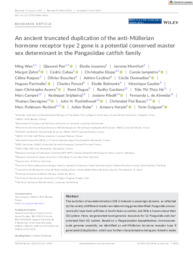An ancient truncated duplication of the anti-Müllerian hormone receptor type 2 gene is a potential conserved master sex determinant in the Pangasiidae catfish family.
An ancient truncated duplication of the anti-Müllerian hormone receptor type 2 gene is a potential conserved master sex determinant in the Pangasiidae catfish family.
Autoria: WEN, M.; PAN, Q.; JOUANNO, E.; MONTFORT, J.; ZAHM, M.; CABAU, C.; KLOPP, C.; IAMPIETRO, C.; ROQUES, C.; BOUCHEZ, O.; CASTINEL, A.; DONNADIEU, C.; PARRINELLO, H.; PONCET, C.; BELMONTE, E.; GAUTIER, V.; AVARRE, J. C.; DUGUE, R.; GUSTIANO, R.; HÀ, T. T. T.; CAMPET, M.; SRIPHAIROJ, K.; RIBOLLI, J.; O'SULLIVAN, F. L. A.; DESVIGNES, T.; POSTLETHWAIT, J. H.; BUCAO, C. F.; ROBINSON-RECHAVI, M.; BOBE, J.; HERPIN, A.; GUIGUEN, Y.
Resumo: The evolution of sex determination (SD) in teleosts is amazingly dynamic, as reflected by the variety of different master sex-determining genes identified. Pangasiids are economically important catfishes in South Asian countries, but little is known about their SD system. Here, we generated novel genomic resources for 12 Pangasiids and characterized their SD system. Based on a Pangasianodon hypophthalmus chromosome-scale genome assembly, we identified an anti-Müllerian hormone receptor type II gene (amhr2) duplication, which was further characterized as being sex-linked in males and expressed only in testes. These results point to a Y chromosome male-specific duplication (amhr2by) of the autosomal amhr2a. Sequence annotation revealed that the P. hypophthalmus Amhr2by is truncated in its N-terminal domain, lacking the cysteine-rich extracellular part of the receptor that is crucial for ligand binding, suggesting a potential route for its neofunctionalization. Reference-guided assembly of 11 additional Pangasiids, along with sex-linkage studies, revealed that this truncated amhr2by duplication is a male-specific conserved gene in Pangasiids. Reconstructions of the amhr2 phylogeny suggested that amhr2by arose from an ancient duplication/insertion event at the root of the Siluroidei radiation that is dated to ~100 million years ago. Together these results bring multiple lines of evidence supporting that amhr2by is an ancient and conserved master sex-determining gene in Pangasiids, a finding that high-lights the recurrent use of the transforming growth factor ? pathway, which is often used for the recruitment of teleost master SD genes, and provides another empirical case towards firther understanding of dynamics of SD systems.
Ano de publicação: 2022
Tipo de publicação: Artigo de periódico
Unidade: Embrapa Amazônia Ocidental
Palavras-chave: Evolution, Hormônio, Male genome assembly, Pangasiid catfishes, Peixe-gato, Sex determination
Observações
1 - Por padrão são exibidas publicações dos últimos 20 anos. Para encontrar publicações mais antigas, configure o filtro ano de publicação, colocando o ano a partir do qual você deseja encontrar publicações. O filtro está na coluna da esquerda na busca acima.
2 - Para ler algumas publicações da Embrapa (apenas as que estão em formato ePub), é necessário ter, no celular ou computador, um desses softwares gratuitos. Sistemas Android: Google Play Livros; IOS: iBooks; Windows e Linux: software Calibre.
Acesse outras publicações
Acesse a Base de Dados da Pesquisa Agropecuária (BDPA) para consultar o acervo completo das bibliotecas da Embrapa.

